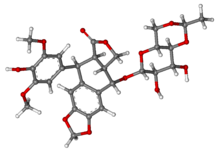 | |
 | |
| Clinical data | |
|---|---|
| Pronunciation | /ˌɛtoʊˈpoʊsaɪd/ |
| Trade names | Etopophos, Toposar, Vepesid, others |
| Other names | VP-16; VP-16-213 |
| AHFS/Drugs.com | Monograph |
| MedlinePlus | a684055 |
| Pregnancy category |
|
| Routes of administration | By mouth, intravenous |
| ATC code | |
| Legal status | |
| Legal status | |
| Pharmacokinetic data | |
| Bioavailability | Highly variable, 25 to 75% |
| Protein binding | 97% |
| Metabolism | Liver (CYP3A4 involved) |
| Elimination half-life | Oral: 6 h., IV: 6-12 h., IV in children: 3 h. |
| Excretion | Kidney and fecal |
| Identifiers | |
| |
| CAS Number | |
| PubChem CID | |
| IUPHAR/BPS | |
| DrugBank | |
| ChemSpider | |
| UNII | |
| KEGG | |
| ChEBI | |
| ChEMBL | |
| CompTox Dashboard (EPA) | |
| ECHA InfoCard | 100.046.812 |
| Chemical and physical data | |
| Formula | C29H32O13 |
| Molar mass | 588.562 g·mol−1 |
| 3D model (JSmol) | |
| Melting point | 243.5 °C (470.3 °F) |
| |
| |
| (verify) | |
Etoposide, sold under the brand name Vepesid among others, is a chemotherapy medication used for the treatments of a number of types of cancer including testicular cancer, lung cancer, lymphoma, leukemia, neuroblastoma, and ovarian cancer.[2] It is also used for hemophagocytic lymphohistiocytosis.[3] It is used by mouth or injection into a vein.[2]
Side effects are very common.[2] They can include low blood cell counts, vomiting, loss of appetite, diarrhea, hair loss, and fever.[2] Other severe side effects include allergic reactions and low blood pressure.[2][4] Use during pregnancy will likely harm the fetus.[2] Etoposide is in the topoisomerase inhibitor family of medication.[2] It is believed to work by damaging DNA.[2]
Etoposide was approved for medical use in the United States in 1983.[2] It is on the World Health Organization's List of Essential Medicines.[5]
- ^ "FDA-sourced list of all drugs with black box warnings (Use Download Full Results and View Query links.)". nctr-crs.fda.gov. FDA. Retrieved 22 Oct 2023.
- ^ a b c d e f g h i "Etoposide". The American Society of Health-System Pharmacists. Archived from the original on 31 March 2016. Retrieved 8 December 2016.
- ^ Yildiz H, Van Den Neste E, Defour JP, Danse E, Yombi JC (January 2020). "Adult haemophagocytic lymphohistiocytosis: a Review". QJM. 115 (4): 205–213. doi:10.1093/qjmed/hcaa011. PMID 31943120.
- ^ World Health Organization (2009). Stuart MC, Kouimtzi M, Hill SR (eds.). WHO Model Formulary 2008. World Health Organization. p. 227. hdl:10665/44053. ISBN 9789241547659.
- ^ World Health Organization (2019). World Health Organization model list of essential medicines: 21st list 2019. Geneva: World Health Organization. hdl:10665/325771. WHO/MVP/EMP/IAU/2019.06. License: CC BY-NC-SA 3.0 IGO.